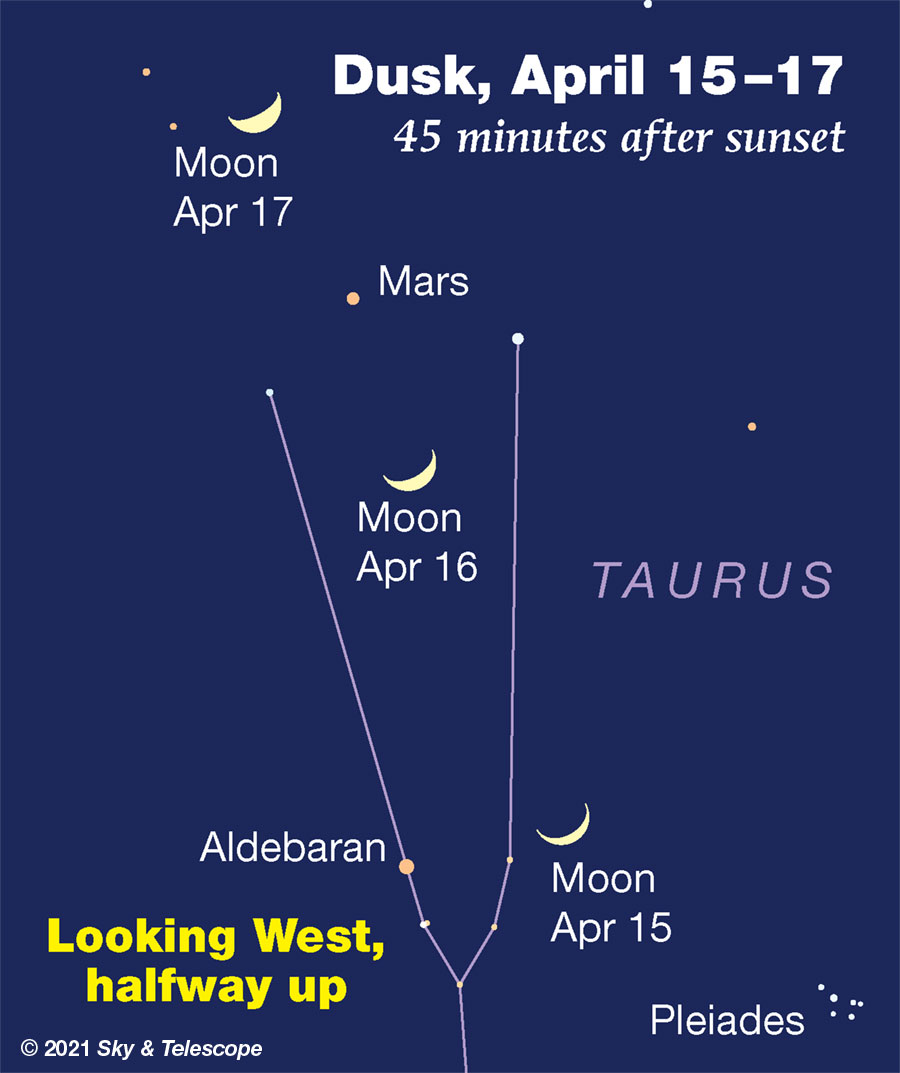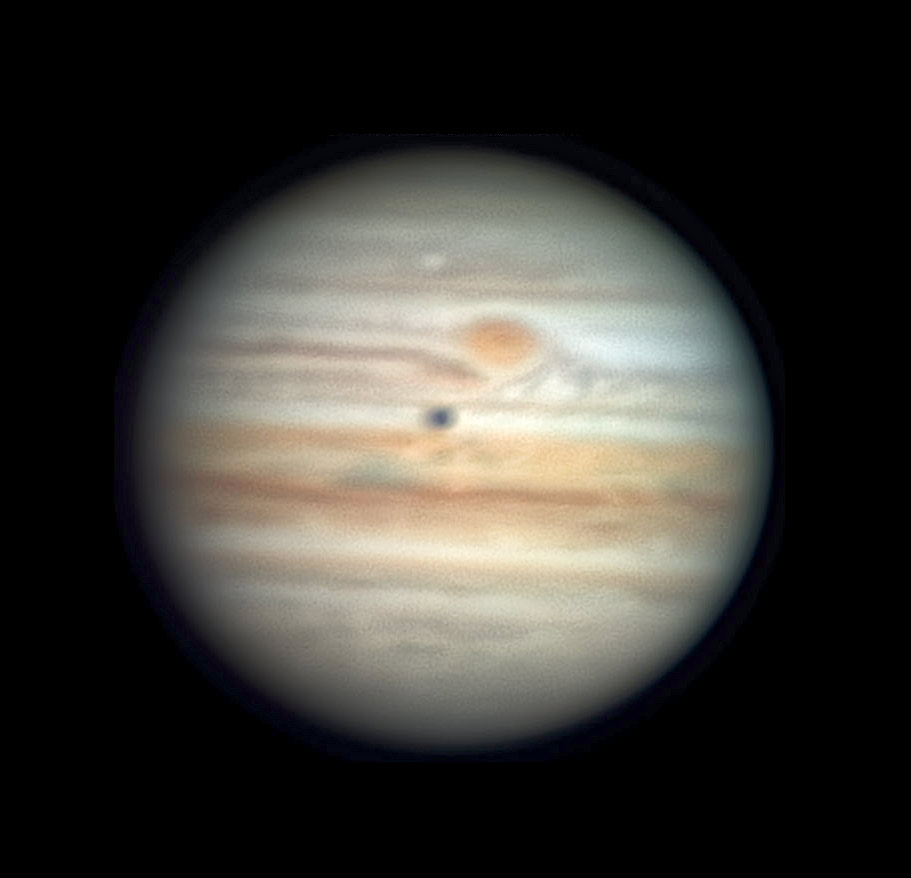Nova Cassiopeiae 2021 (V1405 Cas) was still holding on at about magnitude 8.3 as of April 9th. See Bright Nova Erupts in Cassiopeia.
Comet ATLAS, currently 9th or 10th magnitude, is high in the early-morning sky moving from Aquila toward Hercules, awaiting 6-inch and larger telescopes. See Bob King's Make the Most of Comet ATLAS.
And at the end of that article is info and a chart for the new Nova Sagittarii 2021 No. 2 just off the spout of the Sagittarius Teapot. It's currently 8th magnitude and fairly well up in the south-southeast before the beginning of dawn.
-------------------------------------
FRIDAY, APRIL 9
■ As the stars begin to come out in late twilight, Arcturus, the bright Spring Star climbing up in the east, stands just as high as Sirius, the brighter Winter Star descending in the southwest. They're both about 20° or 25° high for skywatchers at mid-northern latitudes.
These are the two brightest stars in the sky at the time. But Capella is a very close runner-up to Arcturus. Spot it much higher in the northwest in early evening.
SATURDAY, APRIL 10
■ By late evening the Sickle of Leo stands nearly vertical high in the south. Its bottom star is Regulus, the brightest of Leo. Leo himself is walking westward. The Sickle forms his front leg, chest, mane, and part of his head. Off to the left, a long right triangle forms his hind end and long tail.
Spot brighter Procyon nearly four fists to the right of Regulus and a bit lower. About halfway along that line and just a bit below, look for the dim head of Hydra, the Sea Serpent.
SUNDAY, APRIL 11
■ At this time of year, the two Dog Stars stand vertically aligned in late twilight. Look southwest. Brilliant Sirius in Canis Major is below, and Procyon in Canis Minor is high above. They're roughly two fists apart.
■ This is also the time of year when, as the last of twilight fades away, the bowl of the dim Little Dipper extends straight to the right of Polaris in the north.
High above the end-stars of the Little Dipper's bowl, you'll find the end-stars of the Big Dipper's bowl. That pair is almost twice as wide apart.
■ New Moon (exact at 10:31 p.m. EDT).
MONDAY, APRIL 12
■ Mars is crossing the line between the horntips of Taurus, Beta and Zeta Tauri, this evening and tomorrow evening.
Mars is only a bit brighter than Beta. But compare their colors: Beta is a bluish-white B7 star.
TUESDAY, APRIL 13
■ Vega, the bright "Summer Star," rises in the northeast in mid-evening. Exactly where should you watch for it to come up? Spot the Big Dipper very high in the northeast. Look at Mizar at the bend of its handle. If you can see Mizar's tiny, close companion Alcor (binoculars show it easily), follow a line from Mizar through Alcor all the way down to the horizon. That's where Vega will make its appearance.
WEDNESDAY, APRIL 14
■ Arcturus shines brightly in the east these evenings. It's the pointy end of a long, narrow kite-shaped asterism formed by the brightest stars of Bootes, the Cowherd. The kite is currently lying on its side, extending to Arcturus's left. The head of the kite, at the far left, is bent slightly upward. The kite is 23° long, about two fist-widths at arm's length.
THURSDAY, APRIL 15
■ The waxing crescent Moon shines near Aldebaran and the Pleiades this evening, as shown below.

FRIDAY, APRIL 16
■ The waxing crescent Moon this evening forms a quadrilateral with Mars above it and Beta and fainter Zeta Tauri to the sides, as shown above.
SATURDAY, APRIL 17
■ Now the Moon shines upper left of tiny Mars, as shown above.
■ As Arcturus ascends the eastern sky, Capella (its close match for brightness) is coming down in the northwest. They stand at exactly the same height above your horizon at some moment between about 9 and 10 p.m. daylight-saving time, depending mostly on how far east or west you live in your time zone.
This Week's Planet Roundup
Mercury, Venus, Uranus, and Neptune all remain out of sight in the glare of the Sun.
Mars (magnitude +1.4, in Taurus) shines high in the west after dark. Watch it pass between Beta and Zeta Tauri, the horntips of Taurus, on April 12th and 13th. Mars is visibly fainter than orange Aldebaran down below it, not to mention brighter orange Betelgeuse to Mars's left or lower left. In a telescope Mars is a mere 5 arcseconds wide: a tiny, shimmering blob.
Jupiter and Saturn (both in Capricornus) are low in the southeast just before and during early dawn. Saturn is slightly the higher of the two (depending on your latitude), but it's much dimmer at magnitude +0.7. Jupiter shines at magnitude –2.1, about 13° to Saturn's lower left.

South here is up. The northern two thirds of the Equatorial Zone are pale orange tan rather than white. It's bordered on the north by the dark red edge of the North Equatorial Belt.
All descriptions that relate to your horizon — including the words up, down, right, and left — are written for the world's mid-northern latitudes. Descriptions that also depend on longitude (mainly Moon positions) are for North America.
Eastern Daylight Time, EDT, is Universal Time minus 4 hours. Universal Time is also known as UT, UTC, GMT, or Z time. To become more expert about time systems than 99% of the people you'll ever meet, see our compact article Time and the Amateur Astronomer.
Want to become a better astronomer? Learn your way around the constellations. They're the key to locating everything fainter and deeper to hunt with binoculars or a telescope.
This is an outdoor nature hobby. For an easy-to-use constellation guide covering the whole evening sky, use the big monthly map in the center of each issue of Sky & Telescope, the essential magazine of astronomy.
Once you get a telescope, to put it to good use you'll need a detailed, large-scale sky atlas (set of charts). The basic standard is the Pocket Sky Atlas (in either the original or Jumbo Edition), which shows stars to magnitude 7.6.

Next up is the larger and deeper Sky Atlas 2000.0, plotting stars to magnitude 8.5; nearly three times as many. The next up, once you know your way around, are the even larger Interstellarum atlas (stars to magnitude 9.5) or Uranometria 2000.0 (stars to magnitude 9.75). And be sure to read how to use sky charts with a telescope.
You'll also want a good deep-sky guidebook, such as Sky Atlas 2000.0 Companion by Strong and Sinnott, or the bigger (and illustrated) Night Sky Observer's Guide by Kepple and Sanner.
Can a computerized telescope replace charts? Not for beginners, I don't think, and not on mounts and tripods that are less than top-quality mechanically, meaning heavy and expensive. And as Terence Dickinson and Alan Dyer say in their Backyard Astronomer's Guide, "A full appreciation of the universe cannot come without developing the skills to find things in the sky and understanding how the sky works. This knowledge comes only by spending time under the stars with star maps in hand."
![]() Audio sky tour. Out under the evening sky with your
Audio sky tour. Out under the evening sky with your
earbuds in place, listen to Kelly Beatty's monthly
podcast tour of the heavens above. It's free.
"The dangers of not thinking clearly are much greater now than ever before. It's not that there's something new in our way of thinking, it's that credulous and confused thinking can be much more lethal in ways it was never before."
— Carl Sagan, 1996
"Facts are stubborn things."
— John Adams, 1770
 5
5









Comments
Rod
April 9, 2021 at 9:09 am
mary beth, New Jersey Eclipse Fan. I did observe Capella last night along with Arcturus 🙂 Here is a note from my stargazing log, focused on Mizar and Alcor in Ursa Major. [Observed 2030-2130 EDT. Using the 90-mm refractor with 14-mm eyepiece at 71x I could see USNO J1325039+545307 (Starry Night database) ~ 2 arcminute angular separation from TYC3850-257-1. Starry Night Pro Plus 8 shows mv + 11.55 for this star! Very faint star to see in the FOV. Mizar double star ~ 14” angular separation, easy split as a double at 71x. Mizar and Alcor easy double using my eyeglasses (I need those eyeglasses :)). I setup charts using Starry Night and Stellarium 0.21.0 Distinct 10th magnitude 4-star asterism visible left of Mizar double star tonight (north up, mirror reverse view) along with some 11th magnitude stars. While observing Mizar double, TYC3850-257-1 and Alcor in 1 degree true FOV, there were 9th-11th magnitude stars visible using my small refractor telescope 🙂
You must be logged in to post a comment.
mary beth
April 12, 2021 at 10:49 pm
Hi Rod and NJEF! Quite amazing you could see such faint stars! It makes me wonder what the ancient people could see with no light pollution as opposed to what we say with light pollution but with technology.
The crescent moon should be interesting the next few nights. I suppose no one was able to see it this evening because it was so young (less than 1% visible) and set so early tonight.
Here’s a tribute to the Pleiades, that we will soon lose sight of until late autumn....
“Many a night I saw the Pleiades rising thro’ the mellow shade,
Glittering like a swarm of fireflies, tangled in a silver braid.”
Alfred, Lord Tennyson
You must be logged in to post a comment.
Rod
April 13, 2021 at 9:34 am
mary beth, unaided eyes can see to about mv +6.5 in dark skies, just like the ancient world. My 90-mm refractor picked up some stars near 11.5 so about 100x fainter than the ancients could see using unaided eyes. This is one reason why it took the telescope of Galileo to see the tiny lights moving around Jupiter in 1609-1610. Some of those moons are in the 5th-6th magnitude range but are very close to the much brighter Jupiter. Telescopes will pick up much fainter objects and resolve angular sizes much smaller than unaided eye views. Binoculars help, my experience. Telescopes (quality instruments) are best. When skies clear up for (currently cloudy with some rain coming tomorrow), I plan to revisit Mizar and Alcor region using my 10-inch. Starry Night and Stellarium show even fainter stars in that area down to 17th magnitude or so. Perhaps I can see some 12th-13th magnitude stars with my 10-inch in that area.
You must be logged in to post a comment.
mary beth
April 15, 2021 at 10:39 pm
Thank you. Amazing we can see +6.5 unaided if dark sky. I wonder what percent of people have a dark enough skies to say that....not too many these days. I remember seeing some type of rating....Bortle rating I believe. I’ll have to look into that again.
Hope things have cleared up for you to enjoy the beautiful crescent moon unfortunately we are cloudy here until Sunday.
You must be logged in to post a comment.
Rod
April 13, 2021 at 9:39 am
mary beth, NJEF et al. I used TeleVue Everbrite star diagonal with TeleVue 14-mm Delos eyepiece on my 90-mm refractor. The 10-inch also takes the TeleVue eyepieces too.
You must be logged in to post a comment.
You must be logged in to post a comment.